#Half his behaviour is coded into the 'enigma' job and the other half is coded into his character ID
Text
How to tell if your Malroth is a real Malroth or a fake Malroth:
Note: I am not responsible for any mental scaring reliving the mirror scene may cause on both parties.
Other signs of Fake Malroth:
· Does not lurk around you
· Complains about food/wanting to go to the toilet despite toilets and food being avaliable
· No fiery aura
· Does not imedeately run to bed when you go to bed
Only the real Malroth can do these things. It is hard-coded into his being. Watch out for impostors.
#dqb2#dragon quest builders 2#dqb2 malroth#malroth#I guess Malroth's still dead in postgame...he's still a ghost#Half his behaviour is coded into the 'enigma' job and the other half is coded into his character ID#You cannot have 2 characters with the same ID- only the first one is loaded and the second one just duplicates the entry in the register#The stuff I listed is coded into the ID-including the 'no reflection' test#Being unable to eat is coded into the enigma job but not complaining about wanting to eat is coded into the ID#Weird stuff...#I should shut up about code...#03 || Through The Opposite Side
40 notes
·
View notes
Text
Yakkin ‘bout Games: Wolfenstein: The New Order

Yakking ‘bout Games is a series where I talk about games that I’m currently playing or have just finished. It can be new or old, console or PC, good or bad, it really doesn’t matter. If it’s a game worth talking about, you’ll see it covered here.
I think it’s fair to say that the FPS genre has enjoyed a bit of a renaissance over the last decade and a bit. The modern military shooters that dominated the late 2000s and early 2010s have become less common. We have seen the return of classic franchises like Doom and Half-Life, and we have also witnessed the influx of “boomer shooters” like Dusk and Amid Evil. A lot of cool stuff indeed.
With that being said, let’s take a trip back a few years. 2014 to be exact.
This was the first year of the (then) brand spanking new PlayStation 4 and Xbox One. The two consoles were not off to the best of starts though. Their early exclusives like Killzone Shadow Fall, InFamous Second Son, Forza Motorsport 5 and Dead Rising 3 had failed to impress. The only games picking up the slack were multi-platform releases like Assassin’s Creed IV Black Flag. The only FPS games available at the time (other than Killzone on PS4) were Call of Duty Ghosts (dull as dishwater) and Battlefield 4 (I enjoyed it but it was completely broken on release.)
Not exactly the most exciting of times for an FPS fan on console.
Wolfenstein: The New Order finally came along that May. It had been announced the year prior but it didn’t have much fanfare behind it. The initial E3 showing didn’t really impress anyone and there wasn’t really a great excitement for the game’s release. Perhaps it was because the previous Wolfenstein game was largely ignored by people or maybe because people were skeptical due to the game being MachineGames’ (the developer) first effort. People needn’t have worried though. The game turned out to be a massive surprise. It ended up being one of the best of that year.
Why am I covering this now? It’s because I recently got the urge to play it again after all these years. Plus I wanted to see how it would function in a post modern Doom world. So with that in mind, let’s get psyched and see how the game holds up.
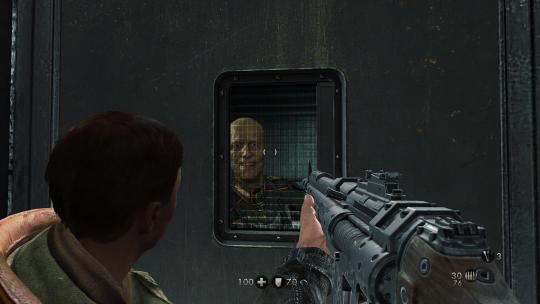
Never has a smile brought terror to my heart so fast. Well this and my last dental appointment...
The New Order is set in an alternate universe where the Nazis won World War II due to their advanced technology being too much for the Allied forces. After an operation to try and assassinate the spearhead behind this growing technological evolution goes horribly wrong, Captain William “B.J.” Blazkowicz ends up taking a piece of shrapnel to the back of the head which puts him into a vegetative state. He ends up spending fourteen years in a Polish mental asylum before finally being awoken again due to witnessing a horrible atrocity committed by the Nazis. B.J. is now in the alien world of 1960 where the Nazis rule over the world with an iron fist. It’s up to B.J. to link up with the remnants of the Resistance and take the fight back to the Nazis once and for all.
The story was and still is one of the most surprising elements of The New Order. It paints a brutal picture of a world controlled by an evil and ruthless force who will stop at nothing to assert their dominance. The cast as well are very memorable. You have the plucky and likable Resistance fighters who you get to spend quite a bit of time with. You then have some memorable encounters with the evil figureheads of the Nazi regime at certain parts of the story. Anyone who has seen the train sequence in this game knows exactly what I’m taking about. I have to give MachineGames credit as well for the characterisation of B.J. himself. They managed to turn a character who was known for being a badass Nazi killer to a very sympathetic and likable Nazi killer. B.J. in this game is weary and tired after years of fighting evil and tyranny at every corner. The man wants nothing more than for the war to be over so he can hang up his guns and finally settle down. How could you hate the man after hearing something like that?
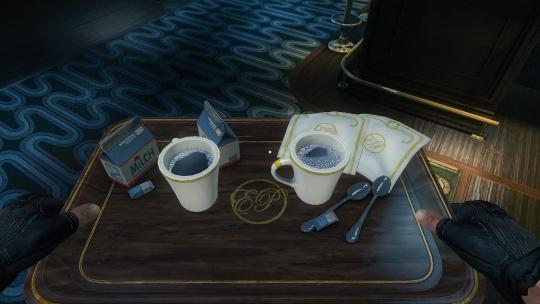
B.J. is such an upstanding guy that he would infiltrate a Nazi controlled train just to get you some coffee. Liberation and a Cappuccino, you can’t beat it.
The real bread and butter of The New Order though is the gameplay. It has held up fantastically for the most part. Combat is a blast thanks to the very meaty arsenal at your disposal including assault rifles, shotguns, marksman rifle and a Laserkraftwerk which allows you to blast enemies to smithereens. You’ll have plenty of enemy types to cut through including rank and file soldiers, big mech suit soldiers with heavy weaponry and robots that have massive lasers. B.J. has a few abilities though to help turn the tide of battle. Leaning is one such ability and it’s implemented very well. How it works is that if you hold the L1 button, it locks B.J. in place and you can then use the left stick to lean at different angles. It’s super useful. Earning a well placed few shots at a Nazi from a very awkward angle never gets old. B.J. also has the ability to dual-wield certain weapons to deal even more hefty damage to his foes. Press up on the d-pad and prepare to bring the carnage. While this is a pretty fun feature, it does limit your movement speed and it can result in you burning through ammo quite quickly. It also is restricted to two types of the same weapon. You can also find upgrades for weapons which give them different ammo types and fire modes. The Laserkraftwerk, for example, can be used to cut through certain boxes and materials which is pretty nifty.
In terms of how health works, it’s a hybrid between classic pick-ups and regeneration. You can recover health by picking up health packs and food throughout the game. Armor can be found as well to allow you to take some extra damage. If you take health damage and managed to find cover, you’ll eventually get 10 health points back. You also have the ability to overcharge your health. How this works is that if you end up picking up a health item that takes you over your max health, you get higher health points for a brief period which is quite useful. You can increase your max health by finding hidden health upgrades throughout some of the levels.
AI is decent for the most part. They will attempt to find cover in the heat of a firefight and they do try to flank you. Some of the heavy soldiers will also attempt to rush your position. I certainly didn’t notice any unusual behaviour from them. Boss fights are a bit unremarkable for the most part. The game pretty much spells out how to take them out and they don’t really put up much of a fight. The main exception being the final boss but even then, it really isn’t that hard.
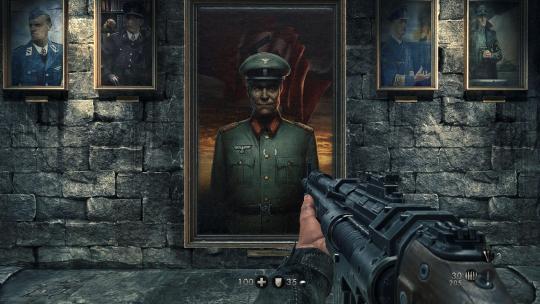
The secret painting boss fight was an interesting idea though. Definitely a canvas for them to work on in the future. (Apologies for the bad pun and joke.)
The game does have a basic stealth system and it works fine. When you enter most of the areas in the game, you will be informed that there are two commanders in the area. Take them out without being spotted and you can sneak through the area without having to worry about reinforcements if you get spotted by an enemy. You can take down enemies stealthily by using a silenced pistol, throwing knives or by sneaking up to them and performing a takedown. Stealth can feel a little overpowered during some of the early sections because the pistol is super accurate and it only takes one headshot to take some of these enemies down. The game does balance this a bit better later on as areas are populated with more elite enemies that harder to kill without being spotted.
Being a Wolfenstein game, you would expect exploration to be a big part of the gameplay and it does play a part for sure. There are hidden areas to be found with collectibles such as the Enigma codes which can unlock new difficulties and cheat codes. You can also find hidden max HP upgrades and other stuff as well. Maps can be found in each level which will indicate possible hidden secrets with a question mark. Levels are definitely more linear than some of the prior Wolfenstein games so don’t expect huge hidden areas or levels.
Key and item hunting still exists of course. You will find doors that require a key or a tool needed to progress which requires a bit of skulking around to find that key or item. You see this especially in the Resistance HQ sections which occur after most of the levels. In these sections, you will be tasked with finding a certain item for a character to progress to the next level. There are also side missions where you can do the same thing for other characters in the HQ and completing these unlocks extras such as artwork. I’m mixed on the Resistance HQ sections overall. On the one hand, they’re good from a lore perspective because you can overhear conversations from some of the characters and there are newspaper clippings and notes to find which do a good job of building up the world. On the other hand, they do feel a little bit like filler. Swings and roundabouts, I suppose...
I don’t really have many issues with the gameplay as a whole. My only real gripe is how the weapon wheel works. Weapon wheels are commonplace on console because a controller doesn’t have many buttons when compared to a keyboard. Makes perfect sense. The New Order’s one however can be such a temperamental thing to use. How it’s supposed to work is that you hit the R1 button to bring up the wheel and then you use the right stick to pick the weapon you want. Sounds simple enough. In reality what happens is that the game ends up giving you the wrong weapon time after time. I can’t even begin to count the amount of times that I tried to switch to the assault rifle and the game switched me to the dual-wield pistols instead. It can be a bloody nuisance. Part of this is down to how sensitive the stick is when using the wheel. It’s way too fast. Also why do the dual-wield options even need to be there? You can already hit up on the d-pad to dual-wield a particular weapon plus I didn’t really need to dual-wield all that much so it’s just clutter. They could have cleaned this up a lot better. I also had issues with swapping back to the previous weapon. It would sometimes default back to the Laserkraftwerk even though it wasn’t my previous weapon. Thankfully these issues didn’t get me killed but they certainly got on my nerves a little bit.
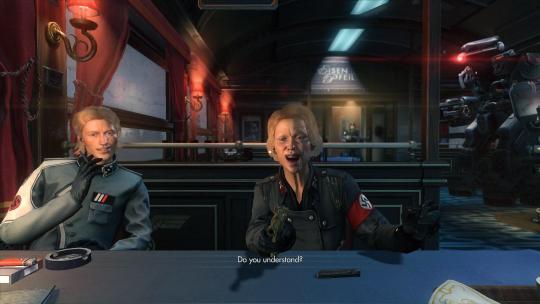
Textbook schadenfreude here from one of the villains. Shouldn’t be that shocked really...
From a graphics point of view, Wolfenstein: The New Order still holds up remarkably well. It runs on the same idTech engine that powered Rage before it and it certainly looks great. Character models are well detailed and they animate well. Cutscenes are well framed and the angles are perfectly done. Environments are beautifully crafted with amazing detail so whether you are in rainy soaked London or even the friggin’ Moon, you feel immersed in the world of the game.
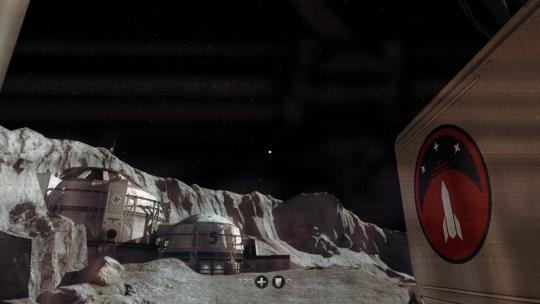
I wasn’t kidding about the Moon. Look Ma, I’m in space! (In a video game...)
The game is quite aliased on the consoles. You definitely see sharp and jagged edges at times. Plus the textures look a bit low-res when viewed up close, but the game still looks great, and I imagine the PC version cleans up most of this stuff anyway so there’s that.
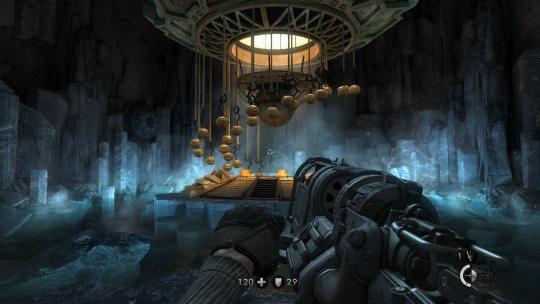
Tumblr’s image compression doesn’t do this environment justice. Oh well. C’est la vie, I suppose...
I can’t fault the game’s sound though. All voice performances are pitch-perfect with Brian Bloom (the voice of B.J.) being the standout. The music is incredible too with a great balance between atmospheric tracks and hard edged ones when the action really kicks off. It’s composed by a guy named Mick Gordon. Don’t think he’s done anything of note since though.
In terms of length, you’re looking at about roughly 8-10 hours for a first time playthrough. There is replay value with the collectibles and the Timeline system. To briefly explain, the Timeline system is related to a choice you make at the start of the game which changes some of the characters you encounter during the game. It doesn’t drastically change much. The events remain the same. You just get some unique dialog and a scene or two. Not much else.
So as you can see, I think that Wolfenstein: The New Order is still a bloody good time. The shooting still feels great with some really meaty weapons, the story and characters are super engaging, and the presentation and sound still kicks some ass. It has some minor issues here and there, but this game is well worth experiencing. You can pick it up pretty cheap nowadays on most of the platforms and it does go on sale quite often.
It’s nice to go back sometimes and revisit a classic, isn’t it?
Check back here soon for Part 2 of this where I take a look at The Old Blood. Until then, stay safe, folks!
13 notes
·
View notes
Text
Film Synopsis
In 1951, two policemen, Nock and Staehl, investigate a break-in at the home of mathematician Alan Turing, whose suspicious behaviour and absence of war records causes Nock to believe that Turing may be a Soviet spy. The police send a man to follow Turing into a pub, where he hands an envelope to a male prostitute, who is arrested shortly afterward and confesses that Turing is a client. Staehl is ready to charge Turing with gross indecency, but Nock is still convinced that Turing is a spy, and begs Staehl to let him interrogate Turing for half an hour, whereupon the latter begins to disclose his top-secret activities during the war.
In 1939, after Britain declares war on Germany, Turing is accepted by Commander Alastair Denniston, of the Royal Navy, for a code-breaking job at Bletchley Park, working alongside Hugh Alexander, John Cairncross, Peter Hilton, Keith Furman, and Charles Richards. They are instructed to break the Enigma codes that the Germans use to encrypt their communications, which, as Maj Gen Stewart Menzies of MI6 explains, allows them to attack British and American shipping, leading to famine and the loss of life.
Turing works in isolation from the others, to the disappointment of his colleagues, and he concentrates all of his efforts in creating a decryption machine, instead of decoding by hand. When Denniston refuses to fund the machine's construction, Turing writes to Winston Churchill, who arranges the funding and names Turing as the team leader. Turing immediately fires Furman and Richards, who are linguists rather than mathematicians, and orders the others to construct the machine with him.
There is a flashback to 1927 when Turing was in the boys-only Sherborne School, where he was bullied by other pupils but was rescued by a boy named Christopher Morcom. The latter introduces him to recreational cryptography and arouses Turing's romantic feelings, but dies after the spring break from bovine tuberculosis, leaving Turing scarred.
Turing's team, which needs more people, places a crossword puzzle in the newspaper and conducts a mathematical examination for candidates, eventually selecting Joan Clarke and Jack Good. Clarke is prevented by her parents from working with an all-male team, so Turing asks her to become one of the telegraph clerks, who are female, and conveys cryptographic materials to her living quarters in secret.
The machine is eventually finished, and Turing names it 'Christopher', but it takes too long to execute, whereas the ciphers of Enigma are changed on a daily basis. Denniston orders the machine to be destroyed and Turing fired, but the other cryptographers threaten to quit. Denniston relents and says he will give the team one month to decode an encrypted German message with the machine.
During this time, Clarke's parents pressure her to leave Bletchley because she is unmarried and alone, and they want her home, so Turing proposes to her so she can stay. At the engagement party, Cairncross advises Turing he is aware of his homosexuality, but warns him to keep it from Joan due to the risk of being caught. During an evening at a local pub, Hugh begins to flirt with a colleague of Joan's named Helen. As they flirt, Helen jokes how she has a crush on a German but cannot pursue him, because she suspects he has a girlfriend based on the messages. Turing asks how she knows, and Helen clarifies that because the messages start with the same word, she suspects that must be someone's name. Because of this, Turing realises that the machine can be sped up by prerecognising routine phrases such as "Heil Hitler" and others from daily weather reports, and the recalibrated machine starts to quickly decode transmissions. However, the team realises that, should the Royal Navy act on the new information, the Germans may realise the Enigma code is broken and redesign it, thereby voiding the team's work.
As such, the team conceals the success of the machine from Denniston and delivers the results to Menzies, who uses his influence to prevent the team from being fired. Menzies works with the team to determine which pieces of information can be used while arousing the least German suspicion. Around this time, Turing discovers that Cairncross is a Soviet spy, but Cairncross argues that the Soviets are allied with the UK and threatens to expose Turing's homosexuality if he tells anyone.
Turing finds Menzies in Clarke's home, suspecting her of being a spy. When Turing reveals that the spy is Cairncross, Menzies explains that he already knew and has been using Cairncross to leak information of low importance.
Shortly afterwards, fearing that Clarke is in trouble because of her secret involvement with the team, Turing reveals to her that he is a homosexual, hoping to drive her away. She is unfazed by this, and Turing lies that he has never cared for her. They break up, but she refuses to leave.
As the war ends, Menzies tells the team to destroy all of their work and never speak of their achievements to the world.
In 1951, back in the interrogation room, Nock is stunned by the story and says that he cannot judge Turing. However, Staehl has the charges pressed, and Turing is given a choice of two years in prison or chemical castration; Turing chooses the latter. He is visited at home by Clarke, who witnesses his physical and mental deterioration. She comforts him by saying that his work saved millions of lives.
In the end, the team is shown in 1945 burning all of their documents, and a caption reveals that Turing committed suicide in 1954, aged 41.
0 notes